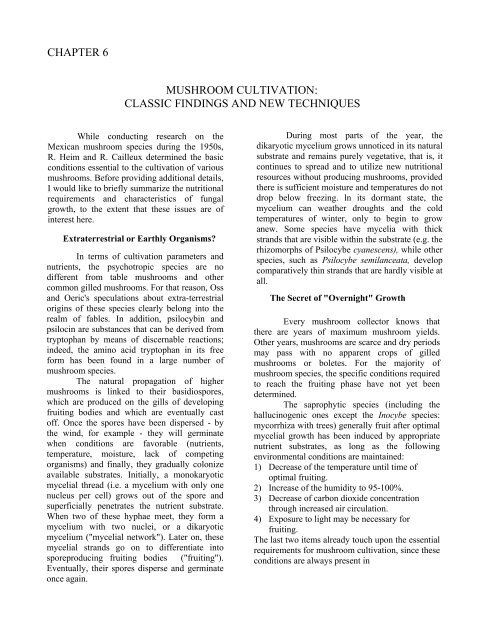Jochen Gartz - Magic Mushrooms Around the ... - preterhuman.net
Jochen Gartz - Magic Mushrooms Around the ... - preterhuman.net
Jochen Gartz - Magic Mushrooms Around the ... - preterhuman.net
Create successful ePaper yourself
Turn your PDF publications into a flip-book with our unique Google optimized e-Paper software.
CHAPTER 6<br />
MUSHROOM CULTIVATION:<br />
CLASSIC FINDINGS AND NEW TECHNIQUES<br />
While conducting research on <strong>the</strong><br />
Mexican mushroom species during <strong>the</strong> 1950s,<br />
R. Heim and R. Cailleux determined <strong>the</strong> basic<br />
conditions essential to <strong>the</strong> cultivation of various<br />
mushrooms. Before providing additional details,<br />
I would like to briefly summarize <strong>the</strong> nutritional<br />
requirements and characteristics of fungal<br />
growth, to <strong>the</strong> extent that <strong>the</strong>se issues are of<br />
interest here.<br />
Extraterrestrial or Earthly Organisms<br />
In terms of cultivation parameters and<br />
nutrients, <strong>the</strong> psychotropic species are no<br />
different from table mushrooms and o<strong>the</strong>r<br />
common gilled mushrooms. For that reason, Oss<br />
and Oeric's speculations about extra-terrestrial<br />
origins of <strong>the</strong>se species clearly belong into <strong>the</strong><br />
realm of fables. In addition, psilocybin and<br />
psilocin are substances that can be derived from<br />
tryptophan by means of discernable reactions;<br />
indeed, <strong>the</strong> amino acid tryptophan in its free<br />
form has been found in a large number of<br />
mushroom species.<br />
The natural propagation of higher<br />
mushrooms is linked to <strong>the</strong>ir basidiospores,<br />
which are produced on <strong>the</strong> gills of developing<br />
fruiting bodies and which are eventually cast<br />
off. Once <strong>the</strong> spores have been dispersed - by<br />
<strong>the</strong> wind, for example - <strong>the</strong>y will germinate<br />
when conditions are favorable (nutrients,<br />
temperature, moisture, lack of competing<br />
organisms) and finally, <strong>the</strong>y gradually colonize<br />
available substrates. Initially, a monokaryotic<br />
mycelial thread (i.e. a mycelium with only one<br />
nucleus per cell) grows out of <strong>the</strong> spore and<br />
superficially pe<strong>net</strong>rates <strong>the</strong> nutrient substrate.<br />
When two of <strong>the</strong>se hyphae meet, <strong>the</strong>y form a<br />
mycelium with two nuclei, or a dikaryotic<br />
mycelium ("mycelial <strong>net</strong>work"). Later on, <strong>the</strong>se<br />
mycelial strands go on to differentiate into<br />
sporeproducing fruiting bodies ("fruiting").<br />
Eventually, <strong>the</strong>ir spores disperse and germinate<br />
once again.<br />
During most parts of <strong>the</strong> year, <strong>the</strong><br />
dikaryotic mycelium grows unnoticed in its natural<br />
substrate and remains purely vegetative, that is, it<br />
continues to spread and to utilize new nutritional<br />
resources without producing mushrooms, provided<br />
<strong>the</strong>re is sufficient moisture and temperatures do not<br />
drop below freezing. ln its dormant state, <strong>the</strong><br />
mycelium can wea<strong>the</strong>r droughts and <strong>the</strong> cold<br />
temperatures of winter, only to begin to grow<br />
anew. Some species have mycelia with thick<br />
strands that are visible within <strong>the</strong> substrate (e.g. <strong>the</strong><br />
rhizomorphs of Psilocybe cyanescens), while o<strong>the</strong>r<br />
species, such as Psilocybe semilanceata, develop<br />
comparatively thin strands that are hardly visible at<br />
all.<br />
The Secret of "Overnight" Growth<br />
Every mushroom collector knows that<br />
<strong>the</strong>re are years of maximum mushroom yields.<br />
O<strong>the</strong>r years, mushrooms are scarce and dry periods<br />
may pass with no apparent crops of gilled<br />
mushrooms or boletes. For <strong>the</strong> majority of<br />
mushroom species, <strong>the</strong> specific conditions required<br />
to reach <strong>the</strong> fruiting phase have not yet been<br />
determined.<br />
The saprophytic species (including <strong>the</strong><br />
hallucinogenic ones except <strong>the</strong> Inocybe species:<br />
mycorrhiza with trees) generally fruit after optimal<br />
mycelial growth has been induced by appropriate<br />
nutrient substrates, as long as <strong>the</strong> following<br />
environmental conditions are maintained:<br />
1) Decrease of <strong>the</strong> temperature until time of<br />
optimal fruiting.<br />
2) Increase of <strong>the</strong> humidity to 95-100%.<br />
3) Decrease of carbon dioxide concentration<br />
through increased air circulation.<br />
4) Exposure to light may be necessary for<br />
fruiting.<br />
The last two items already touch upon <strong>the</strong> essential<br />
requirements for mushroom cultivation, since <strong>the</strong>se<br />
conditions are always present in








![The Big Lie 9-11 and Government Complicity in Mass Murder [PDF]](https://img.yumpu.com/50957077/1/190x245/the-big-lie-9-11-and-government-complicity-in-mass-murder-pdf.jpg?quality=85)








